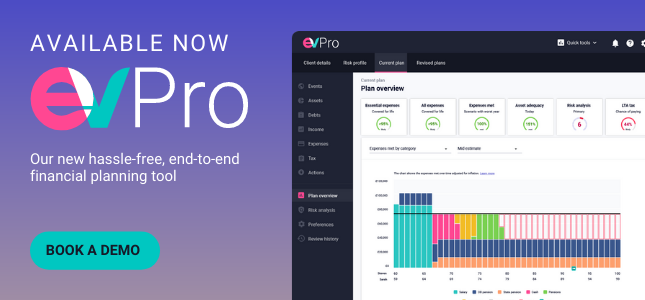How to deliver good outcomes in an era of high inflation and higher tax

The UK Government and the Bank of England have spoken. In an effort to balance the nation’s books and press down on inflation, they have implemented policy steps that mean all of us will be living in an environment of higher income tax takes and higher interest and mortgage rates amid high general inflation that may take quite a time to subdue.
In recent weeks and months, advisers will have been busy striving to reassure clients concerned about their future income in this time of alarm-bell headlines, such as ‘cost of living crisis’, ‘high-inflation’, ‘drop in standard of living’, ‘tax going up’, ‘income squeeze’, ‘pension funds under pressure’, ‘stock markets still down’, and more.
A reality check
One aspect of the current higher inflation environment particularly impinges on the norms of financial planning. EV’s inflation forecast at the higher end projects a rolling average of 7% over 2022-24, based on realistic RPI as opposed to the official CPI rate (the latter excludes housing costs). In these economic conditions, it’s clear that incorporating an assumption of 2.5% inflation in a financial plan, as has been common practice for many advisers for the past decade, based on the FCA’s Conduct of Business Sourcebook (COBS), is no longer tenable. Indeed, continuing with this could fall foul of the Consumer Duty principle of avoiding foreseeable harm to investors.
High inflation will also impact the amount of income tax people pay. With the additional tax rate reduction (in England, Wales and Northern Ireland) from £150,000 to £125,140 in April 2023 and the other tax thresholds froze for five years to 2028, more people will be drawn into higher tax bands and face increased tax deductions. The Office for Budget Responsibility (OBR) estimates that freezing the income tax thresholds will create 3.2 million new taxpayers and 2.6 million higher-rate taxpayers, raising an extra £26 billion per year for the government by the financial year 2027-20281.
The twin impact of increased taxation and the effect of inflation is that most earners will see a reduction in the spending power of their income. Many of your clients will be concerned about their future income, with those near or at retirement having less ability to increase their earnings particularly affected.
Increase in total tax paid (£)
Source EV, as of November 2022.
The problem for advisers is that no one has a crystal ball to know exactly what will happen to inflation over the next five years. But the impact on people’s cash flow if the wrong calculation is used can be enormous. Looking at the graph above, those earning £55,000 could pay £6,000 more in additional income tax if inflation is 7% rather than 2.5%, while at £100,000, the additional tax would be around £14,000.
The solution to creating realistic estimates and understanding the likelihood of the client covering their expenses based on different levels of inflation, changes in market performance and so on rests on the ability to test the level of client income attainable in all manner of possible future scenarios. Armed with this information, you can reassure the client that they’re still on track with their plan or identify where they need to adjust spending or saving to get back in good shape.
This is where we can help with our stress-testing planning tool purpose-built for this activity.
We are on your side
We’re here to help advisers comfort their clients in good times and bad. The Solver module within EVPro – our end-to-end advice journey tool – is available to do the heavy lifting for that very purpose.
Solver applies stochastic modelling to make thousands of calculations designed to stress-test multiple ‘what if’ scenarios, culminating in the probability of a client reaching their future income targets, expressed as a percentage. Advisers can use this understandable information either to reassure the client all is well despite their current concerns or work with them to change existing or future provisions, averting the jolt of becoming aware of shortfalls when it’s too late. And none too soon in this current environment of economic disturbance.
Specifically, with EVPro to hand, you get the functionality to stress-test a range of vital factors, including:
- Probability of meeting expenditure – covering every year from the present to the end of the plan
- Expenses met – indicating the worst-case scenario, i.e. by how much the expenditure target is met if there is a shortfall
- Asset adequacy – the proportion by which all the assets could be adjusted, and the expenditure still met with the target probability.
Ease of use is built in. You can stress-test numerous scenarios and potential outcomes with button clicks on EVPro.
You can't control turmoil, but you can plan for it
Although the significant difference advisers make to their client’s futures, you can’t be expected to be a fortune teller. A financial planner's role is to ensure clients have the right expectations and know what they need to do to achieve their desired income. Ultimately, providing your clients with comfort and peace of mind about their finances in an uncertain world is where your true value comes into play.
We’re here to partner with you to help you reach your firm’s objectives and help your clients meet their financial goals.
So what next?
Source
1https://obr.uk/docs/dlm_uploads/CCS0822661240-002_SECURE_OBR_EFO_November_2022_WEB_ACCESSIBLE.pdf
